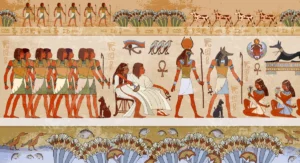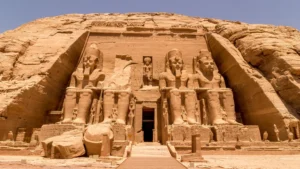Herodotus, the Greek historian, gave Egypt its nickname of the Gift of the Nile due to their dependence on it for water, food, transportation, trade, papyrus production and trade, fisheries, wildlife habitat and rich black soil.
Every year, the Nile River would flood through Egypt’s desert land and leave behind fertile silt that gave birth to life there. This was how life was birthed in this ancient civilization.
You may also like: Protective Geographical Features of Egypt
1. The Nile River is the Lifeline of Egypt
Egypt, located in North Africa and considered one of the cradles of civilization, relies heavily on its lifeblood river for transportation and agricultural needs. From Lake Tana in Ethiopia down to the Mediterranean Sea, Egypt’s Nile was, for millennia, its primary source of fresh water for agricultural purposes and served as a transportation means essential to trade and travel activities.
Egyptians believed that the annual flooding of the Nile was a gift from their gods. Each summer, heavy rains from Central Africa would wash across Egypt and flood it, leaving behind rich silt that made for fertile agricultural land – leading directly to Egypt’s rise as a civilization. Egyptians relied on it for farming their crops, which contributed to their civilization’s advancement.
Without the Nile, Egypt would have been an inhospitable desert. Serving as its sole source of water in this part of Africa, the river enabled agriculture for food cultivation as well as drinking water supplies to people along its banks. Egyptians also utilized it as a transportation artery, using boats to carry materials needed for mining expeditions, trading operations, architecture projects and more.
2. The Nile River Provides Water
The Nile River runs through northwest Africa and is the world’s longest river. It provided Egyptians with drinking water, food, transportation and building materials, as well as played an integral role in ancient Egyptian history.
Early civilizations emerged along the Nile River due to the rich black soil it produced annually due to annual floods. When spring, snowmelt would fill Nile fields with water, helping farmers grow crops even in desert environments.
Farmers relied on this water source to cultivate their land and provide food and other necessities, including wheat, barley, flax used in clothing manufacturing and reeds for papyrus production.
Egyptians believed the Nile River to be their country’s lifeblood and venerated it accordingly. They venerated Khnum and Hapi, two gods who represented it and oversaw its effects – annual flooding that provided fertile silt needed by people and plants to thrive in an otherwise desert setting; furthermore, they could control how much water was available and prevent it from rising too fast, drowning people or leaving the land barren of fertility.
3. The Nile River Provides Food
Egypt relied on the Nile’s annual flooding to secure its food supply, such as grains for making bread and vegetables for making molokhia, and raise livestock for meat products like halloumi cheese and kariesh cheese.
Each year, snowmelt from mountains in the south causes the Nile River to overflow its banks on its journey north towards Egypt, creating a lush, green region with fertile volcanic black soil and turning desert terrain into a fertile, lush landscape.
Floodwaters not only brought crop-seeding assistance to Egyptians, but they also brought fresh layers of silt deposited by floods that transformed dry land into rich, fertile land suitable for living and working in. Egyptians began cultivating and harvesting emmer wheat to make bread, vegetables for making molokhia, fruits and legumes for making kosher, and other staple foods.
Nile River provided abundant crops that allowed people to lead luxurious lives and construct superb temples and monuments, including palace temples. Pharaohs and their nobles enjoyed lavish lifestyles that included dates, honey, beer, wine and spices; exotic animals like camels and wild boar could even be consumed! Thus making this great river one of nature’s great gifts known as The Gift of Nile.
4. The Nile River Provides Soil Fertility
As part of its annual flooding cycle, the Nile brought rich sediment from volcanic uplands down onto ancient Egyptian fields during flood season, producing rich silt that made the land immensely fertile and enabled civilization in Egypt to flourish for over 5,000 years.
The Nile River rises yearly from its sources in Ethiopia and South Sudan, bringing floods to its delta region and surrounding desert areas. At its height in September, Aswan saw the Nile’s widest point with near coverage across southern Egypt – it carried huge quantities of vegetation, including tall grasses, sedges, papyrus, and aquatic plants that often choked up its flow and created barriers called sudds choking off access to it altogether.
Every year, at approximately the same time, flood waters recede. Ancient Egyptians adapted this pattern and tailored their farming practices accordingly, developing basin irrigation. Fields on flat floodplains were divided by earth banks into basins that filled during flood season but then allowed to remain until water receded again.
With their predictable flood patterns, Egyptian farmers could plan their farming schedule. When fields were flooded from August to November, work would commence immediately, followed by rest periods during winter months.
5. The Nile River Provides Irrigation
Egypt relied heavily on irrigation from the Nile River. Its annual floods allowed farmers to cultivate its rich black soil along its banks, thus making civilization possible in a desert environment.
Late each summer, the Nile would flood its banks and deposit silt rich with nutrients and water into Egypt’s fields, replenishing them with much-needed moisture and fertilizers that made cultivation possible. On a good year, these fields could produce enough food to supply all Egyptians; any surplus was stored away in granaries for later use during leaner times.
Egyptians, over time, developed an elaborate irrigation system to support their agriculture and economy. Earthen banks divided the flat floodplain into basins of various sizes with regulated sluices used to direct floodwater into each one; when flooding receded, canals carried off-river drainage water into canals for drainage purposes.
As well as providing food and water, the Nile transported Egyptians across their vast nation. Although modern air, rail, and highway infrastructure has reduced reliance on this river as a transportation route today, its waters continue to provide vitality for agriculture and other uses.
6. The Nile River Provides Shelter
Every June, snow on the mountains to the south would melt, and floodwaters would rise along the Nile River, flooding much of Egypt’s land but providing vitally fertile soil for crops, silt deposits for building homes, walls and other structures, and soil fertility to Egyptian farmers. Although flooding sounds bad today, Egyptian farmers saw it as beneficial: using Nile floodwaters as fertile soil for their fields and building homes, walls, and other buildings on top of its floods to aid their farming needs.
The Nile River enabled Egyptians to both fish and hunt for food. Furthermore, its abundant supply allowed Egyptians to cultivate various vegetables, fruits, and grains near its banks – helping ensure a steady population without fear of famine.
Boats were crucial in transporting people between cities along the Nile River. Boat travel made trading easier between cities for what they needed, as well as visiting tombs and pyramids across Egypt. Furthermore, boat travel played an integral part in Ancient Egyptian religion – considered sacred by their gods and considered an emblem of fertility and renewal by society as a whole. Khnum was considered their Nile god whose presence brought life and renewal to both the riverbank and the land around him.
7. The Nile River Provides Culture
The Nile River provided ancient Egyptians with essential resources and something to believe in, leading them to develop an entire culture within a desert climate.
Each year, the Nile River would flood for six months and provide farmers with fertile land suitable for farming, as well as providing building material in the form of mud used to construct homes and boats. Furthermore, its waters served as food sources for local wildlife like ducks and geese as well as fish and water snakes; furthermore, it provided an ideal place for hunting game like wild boar and crocodile.
Egyptians placed great value in the annual flood, so much so that they developed a calendar around it. Nileometers (stone columns that marked the water level in the Nile) helped Egyptians know when it was best to plant and harvest crops.
Ancient Egyptians believed the Nile River was a blessing from their gods, so they dedicated themselves to caring for it and cultivating crops along its banks while building cities centred on Pharaonic architecture – thus forging a powerful civilization within Egypt itself.




